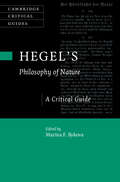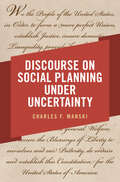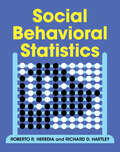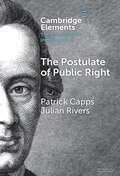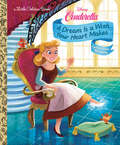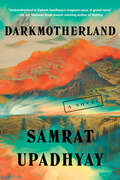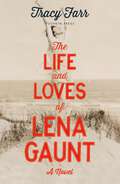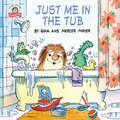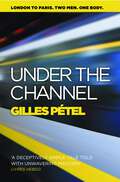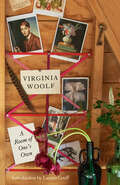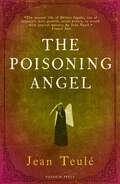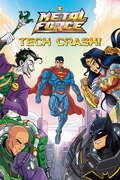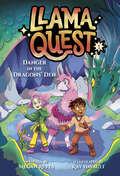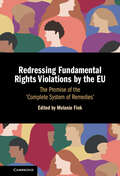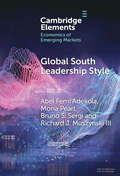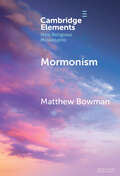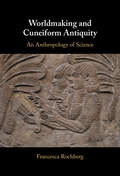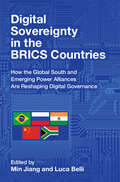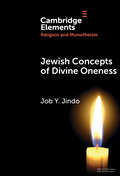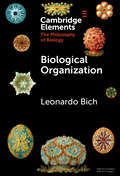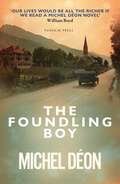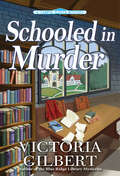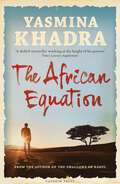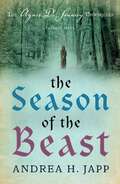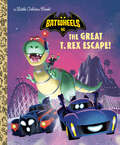- Table View
- List View
Hegel's Philosophy of Nature: A Critical Guide (Cambridge Critical Guides)
by Marina F. BykovaHegel's Philosophy of Nature constitutes the second part of his mature philosophical system presented in the Encyclopaedia of the Philosophical Sciences, and covers an exceptionally broad spectrum of themes and issues, as Hegel considers the content and structure of how humanity approaches nature and how nature is understood by humanity. The essays in this volume bring together various perspectives on Hegel's Philosophy of Nature, emphasizing its functional role within the Encyclopaedia and its importance for understanding the complexity of Hegel's philosophical project. Together they illuminate the core ideas which form Hegel's philosophical framework in the realm of nature.
Discourse on Social Planning under Uncertainty
by Charles F. ManskiEconomists have long studied policy choice by social planners aiming to maximize population welfare. Whether performing theoretical studies or applied analyses, researchers have generally assumed that the planner knows enough about the choice environment to be able to determine an optimal action. However, the consequences of decisions are often highly uncertain. Discourse on Social Planning under Uncertainty addresses the failure of research to come to grips with this uncertainty. Combining research across three fields – welfare economics, decision theory, and econometrics – this impressive study offers a comprehensive treatment that fleshes out a 'worldview' and juxtaposes it with other viewpoints. Building on multiple case studies, ranging from medical treatment to climate policy, the book explains analytical methods and how to apply them, providing a foundation on which future interdisciplinary work can build.
Social Behavioral Statistics
by Roberto R. Heredia Richard D. HartleyFocusing on practical application, this textbook provides clear and concise explanations of statistical tests and techniques that students can apply in real-world situations. It has a dual emphasis: firstly, on doing statistics, and secondly, on understanding statistics, to do away with the mindset that statistics is difficult. Procedural explanations are provided so students know how to apply particular statistical tests and techniques in practical research situations. Conceptual understanding is encouraged to ensure students know not only when and how to apply appropriate techniques, but also why they are using them. Ancillary resources are available including sample answers to exercises, PowerPoint teaching slides, instructor manual, and a test bank. Illustrative figures, real-world data, practice exercises, and software instruction make this an essential resource for mastering statistics for undergraduate and graduate students in the social and behavioral sciences.
The Postulate of Public Right (Elements in the Philosophy of Immanuel Kant)
by Patrick Capps Julian RiversKant's main work in the philosophy of law – the Doctrine of Right (1797) – is notoriously difficult for modern readers to understand. Kant clearly argues that rightful relations between human beings can only be achieved if we enter into a civil legal condition taking a defined constitutional form. In this Element, we emphasise that Kant considers this claim to be a postulate of practical reason, thus identifying the pure idea of the state as the culmination of his entire practical philosophy. The Doctrine of Right makes sense as an attempt to clarify the content of the postulate of public right and constructively interpret existing domestic and international legal arrangements in the light of the noumenal republic it postulates. Properly understood, Kant's postulate of public right is the epistemological foundation of a non-positivist legal theory that remains of central significance to modern legal philosophy and legal doctrinal method.
A Dream Is a Wish Your Heart Makes (Little Golden Book)
by Golden BooksSing and dream along with Princess Cinderella in this beautiful Little Golden Book featuring the lyrics to &“A Dream is a Wish Your Heart Makes&”!Princess Cinderella has big dreams in her heart, and she&’s determined to make them come true! This beautifully illustrated Little Golden Book featuring the lyrics to the beloved song &“A Dream is a Wish Your Heart Makes&” and scenes from Disney&’s Cinderella is sure to be a treasure for children ages 2 to 5 as well as Little Golden Book collectors and Disney fans of all ages.Check out these other Disney lyrics Little Golden Books:Do You Want to Build a Snowman? (Disney Frozen)Part of Your World (Disney The Little Mermaid)Circle of Life (Disney The Lion King)Little Golden Books enjoy nearly 100% consumer recognition. They feature beloved classics, hot licenses, and new original stories. . . the classics of tomorrow.
Darkmotherland
by Samrat Upadhyay&“A Dickensian sweep and a vast cast of characters, Upadhyay created an ancient world saturated with the spirit of our time and shaped by political ambition and dark vision . . . A grand novel indeed.&” —Ha Jin, National Book Award–winning author of WaitingAn epic tale of love and political violence set in earthquake-ravaged Darkmotherland, a dystopian reimagining of Nepal, from the Whiting Award–winning author of Arresting God in Kathmandu In Darkmotherland, Nepali writer Samrat Upadhyay has created a novel of infinite embrace—filled with lovers and widows, dictators and dissidents, paupers, fundamentalists, and a genderqueer power player with her eyes on the throne—in an earthquake-ravaged dystopian reimagining of Nepal.At its heart are two intertwining narratives: one of Kranti, a revolutionary&’s daughter who marries into a plutocratic dynasty and becomes ensnared in the family&’s politics. And then there is the tale of Darkmotherland&’s new dictator and his mistress, Rozy, who undergoes radical body changes and grows into a figure of immense power.Darkmotherland is a romp through the vast space of a globalized universe where personal ambitions are inextricably tied to political fortunes, where individual identities are shaped by family pressures and social reins, and where the East connects to and collides with the West in brilliant and unsettling ways.
The Life and Loves of Lena Gaunt
by Tracy FarrOctogenarian musician Lena Gaunt lives quietly in the Perth suburbs. An early embracer of electronic music, she found fame in Jazz-age Sydney as a virtuoso of the theremin and travelled the world before settling down to a life of daily swims... and a decades-old heroin habit.Now, for the first time in 20 years, she's performing at a festival again. In the audience is documentary filmmaker Mo Patterson. Lena's extraordinary past makes her an intriguing film subject: but is she prepared to reveal the secrets she has guarded for so long?Spanning continents and much of the twentieth century, from colonial Malacca to post-war Europe, this is a story of talent, modernity and belonging, of a woman shaped by the ebb and flow of love and loss, and the constant pull of the sea.
Just Me in the Tub (Pictureback)
by Mercer Mayer Gina MayerSplish, splash! Little Critter grabs some toys and a towel for his bubble bath in this adorable storybook which is perfect for bedtime readings!Little Critter runs the water, adds the bubbles and washes his face, hair and feet (even between the toes!) in this adorable picture book. It&’s perfect for pre-bath or bedtime reads!
Under the Channel
by Gilles PetelWhen the body of a Scotsman turns up on board a Channel Tunnel train at the Gare du Nord, Parisian detective Roland Desfeuillères finds himself in charge of a murder investigation. This inter-city tale of changing identities is no ordinary crime novel.
A Room of One's Own (Vintage Classics)
by Virginia WoolfVirginia Woolf&’s classic plea for a world in which women are free to use their gifts is as powerful and resonant as ever.In this influential extended essay, Virginia Woolf outlined what women need in order to fully make use of their abilities. Using powerful images and memorable thought experiments--such as a fictional sister of William Shakespeare, who is as talented as her brother but limited in ways he was not--Woolf analyzes the many ways in which women have been held back throughout history and still are in her own time. First published in 1929, A Room of One's Own has been a towering and inspirational statement of feminist principles for nearly a century--and remains relevant now, at a time of growing awareness of the kind of social injustices that she decried.
The Poisoning Angel
by Jean TeuléShe came. She cooked. She killed.Little Hélène Jégado was always different. Schooled in the ancient beliefs of the Breton people by her mother, the beautiful child grew up feeling detached from the nineteenth-century world around her. Her destiny was to do the work of the Ankou, Death's henchman. Beginning with the demise of her very own maman...Jean Teulé brings his unique blend of imagination and historical insight to the startling tale of Hélène Jégado, one of the most notorious poisoners of all time.
Tech Crash! (A Stepping Stone Book)
by Alex SeguraJoin Batman, Superman, and the Justice League as they armor up for a thrilling, hi-tech adventure where Super Heroes and Super-Villains must unite to battle for the ultimate power in the universe. This action-packed and Manga-style chapter book is perfect for young readers and DC fans alike.When a powerful alien entity is hacked by an Earth villain, the universe is in peril. Batman, Superman, and Wonder Woman unite with DC's mightiest heroes and villains to confront this threat. Now they must harness alien technology to unleash the full might of their amazing mech suits while also overcoming their mistrust of their archenemies to work together. Brace for a high-stakes, world-spanning adventure where the fate of the whole universe hangs in the balance with Manga-style art.
Llama Quest #1: Danger in the Dragons' Den (Llama Quest)
by Megan ReyesStart your quest with a talking purple llama and protect the Kingdom of Ravenwood! Join eight-year-old Dak as he's swept into a magical adventure to protect the people and creatures of their kingdom—including dragons!Eight-year-old Dak spends his days scooping llama poop and dreaming of adventure. Then he meets Fenn, the mysterious girl who lives next to his family&’s farm, and Lucy, a llama…who wears a scarf? And talks? And turns PURPLE?!Suddenly Dak is on a magical whirlwind adventure! Turns out Lucy is the keeper of the magical stones that protect the people of Ravenwood —and a thief has tried to steal them. Now they're scattered across the kingdom! The good news? Lucy has found the Fire Stone. The bad news? A family of dragons found it first and they won&’t give it up easily. Can Dak, Fenn, and Lucy get the Fire Stone back? They&’ll encounter magical creatures, a sneaky thief, and tricky magic, but when Dak, Fenn, and Lucy work together, nothing can beat Team Llama Quest! Join Team Llama Quest on all their adventures! #1 Danger in the Dragons' Den#2 Secrets of Starfall Forest
Redressing Fundamental Rights Violations by the EU: The Promise of the ‘Complete System of Remedies'
by Melanie FinkThe EU prides itself on having created a legal system that puts the individual at its centre. Individuals benefit from a broad range of fundamental rights that protect them against EU power. However, to vindicate their rights against the EU, they have to make use of a remedies system as old as the EU itself. Unsurprisingly, with EU power growing and evolving, it also is increasingly difficult to challenge. This book critically examines the EU's remedies system from a fundamental rights perspective, focusing on the EU's activities outside the realm of lawmaking. It maps the existing mechanisms private parties can avail themselves of to enforce their fundamental rights against the EU and discovers their unused potential. In doing so, it offers an important synthesis of the state of play and directions for reform in areas where the EU falls short of its promise to provide a 'complete system of remedies'. This title is also available as Open Access on Cambridge Core.
Global South Leadership Style: Strategies for Navigating Emerging Market (Elements in the Economics of Emerging Markets)
by Abel Femi Adekola Mona Pearl Bruno S. Sergi Richard J. Muszynski IIIThe Global South consists of emerging nations with increasing economic and political strength, drawing attention to their unique leadership challenges and opportunities. Visionary leaders from the Global South leverage their political and economic influence to challenge the status quo and reshape the global order. Thus, Global South's leadership has the potential for a revolutionary future, defined by its distinctive experiences, creative energy, and dedication to a more sustainable global order. This Element promotes a new paradigm shift by acknowledging the regions as a unique leadership concept rather than a geographical classification. The Global South Leadership Index identifies new players, agendas, and pathways to provide a framework for other countries who want to follow suit. The Element sidesteps labeling leaders explicitly with terms like democratic or dictatorial. It allows readers to interpret the governance style and leadership dynamics for themselves, resulting in a more nuanced understanding.
Mormonism (Elements in New Religious Movements)
by Matthew BowmanThis Element will focus on the various denominations in the Mormon tradition, collectively sometimes referred to as 'Mormonism.' They include the Church of Jesus Christ of Latter-day Saints as well as the several sects of Mormon fundamentalism and multiple other denominations. Often described as the quintessential new religious movement, Mormonism is useful for studying the dynamics of new religious formation, evolution, schism, and adaptation to American culture more broadly. It emerged in the heat of the Second Great Awakening, the flourishing of religious creativity and innovation that followed American disestablishment, inspired by the visionary ideas of Joseph Smith, Jr., a New York farmer who adopted a particular style of restorationism, a form of Christianity popular in the period. Since that time, the various branches of Mormonism have embraced different relationships with the broader stream of American culture. Some have sought integration with America's Protestant majority; others have emphasized sectarian distinctiveness.
Worldmaking and Cuneiform Antiquity: An Anthropology of Science
by Francesca RochbergObjects of knowledge exist within material, immaterial, and conceptual worlds. Once the world is conceived from the perspective of others, the physical ontology of modern science no longer functions as a standard by which to understand other orderings of reality, whether from ethnographical or historical sources. Because premodern and non-western sources attest to a plurality of sciences practiced in accordance with different ways of worldmaking from that of the modern West, their study belongs to the history of science, the philosophy of science, and the sociology of science, as well as the anthropology of science. In Worldmaking and Cuneiform Antiquity, Francesca Rochberg extends an anthropology of science to the historical world of cuneiform texts of ancient Babylonia. Exploring how Babylonian science has been understood, she proposes a new direction for scholarship by recognizing the world of ancient science, not as a less developed form of modern science, but as legitimate and real in its own right.
Digital Sovereignty in the BRICS Countries: How the Global South and Emerging Power Alliances Are Reshaping Digital Governance (Communication, Society and Politics)
by Luca Belli Min JiangIn a world where digital development and policymaking are dominated by Silicon Valley tech giants, the BRICS countries - Brazil, Russia, India, China, and South Africa - play an increasingly important role. With forty percent of the world's population and twenty-five percent of global GDP, these nations possess vast troves of personal data. Yet, their conceptions, narratives, and initiatives of digital sovereignty remain understudied. This volume is the first to explore digital sovereignty from a Global South perspective and offers a forward-looking take on what a world less dependent on Silicon Valley might look like. It brings together excellent analyses of BRICS digital sovereignty issues, from historical imaginaries to up-to-date conceptualizations, e-payment to smart cities, legal analysis to geopolitical assessment. By offering neglected perspectives from the Global South, this book makes important contributions to the digital sovereignty debate. This title is also available as Open Access on Cambridge Core.
Jewish Concepts of Divine Oneness: A Comparative Introduction (Elements in Religion and Monotheism)
by Job Y. JindoThis book offers a selective, typological overview of Jewish perspectives on the belief in God's oneness. To achieve this, the author divides the history of Judaism into four phases-biblical, rabbinic, medieval, and moder-and presents diverse models for understanding the reality of divine oneness within each phase. These models not only offers insight into different perspectives on the topic but also illuminate diverse layers of polemical discourse in the Jewish tradition, whether internal or in dialogue with other religions and worldviews. In addition, the author invites readers to consider how to think about the plurality of the perspectives at hand, and if and how such meta-reflection can enrich the lives of contemporary readers, Jewish and non-Jewish alike. No prior knowledge of Judaism is necessary.
Biological Organization (Elements in the Philosophy of Biology)
by Leonardo BichLiving systems are complex systems made of components that tend to degrade, but nonetheless they maintain themselves far from equilibrium. This requires living systems to extract energy and materials from the environment and use them to build and repair their parts by regulating their activities based on their internal and external conditions in ways that allow them to keep living. The philosophical and theoretical approach discussed in this Element aims to explain these features of biological systems by appealing to their organization. It addresses classical and more recent issues in philosophy of biology, fromorigins and definitions of life to biological teleology and functions, from an original perspective mainly focused on the living system, its physiology and behavior, rather than evolution. It discusses and revises the conceptual foundations of this approach and presents an updated version of it. This title is also available as Open Access on Cambridge Core.
The Foundling Boy
by Michel DéonIt is 1919. On a summer's night in Normandy, a new-born baby is left in a basket outside the home of Albert and Jeanne Arnaud. The childless couple take the foundling in, name him Jean, and decide to raise him as their own, though his parentage remains a mystery. Though Jean's life is never dull, he grows up knowing little of what lies beyond his local area. Until the day he sets off on his bicycle to discover the world, and encounters a Europe on the threshold of interesting times...
Schooled in Murder
by Victoria GilbertA mystery writer must solve a real murder case before an innocent girl is condemned in this series debut from acclaimed author Victoria Gilbert, perfect for fans of Ellery Adams and Lorna Barrett.Jennifer "Jen" Dalton is an author and educator at Clarion University in Virginia. She loves her job, but some of her petty coworkers look down on her for writing genre fiction. As members of the English department, they wish to encourage students to pursue higher literary aspirations. When a humiliating confrontation between an uppity professor and one of Jen&’s students, Mia, escalates, no one thinks much of it. Until his dead body is found along with evidence incriminating Mia. Jen knows Mia couldn&’t have killed him, but Mia&’s suspicious disappearance might as well be a proclamation of guilt. With the sleuthing skills Jen has acquired writing murder mysteries, she&’s determined to solve the case and clear Mia&’s name. Along with the help of her fellow sleuthers—Christine Kubiak, a cafeteria manager; Zachary Flynn, the charming but annoying campus psychologist; and Brianna Rowley, a librarian—Jen must catch the real killer before there&’s another murder on the books.
The African Equation
by Yasmina KhadraKurt Krausmann, a recently bereaved Frankfurt doctor, is persuaded to join his friend, wealthy benefactor Hans Makkenroth, on a humanitarian mission to the Comoros. The journey helps him begin to confront his loss, but soon misfortune strikes again: the boat he and Hans are travelling in is hijacked in the Gulf of Aden and the men are taken hostage. Held in a remote hideout, the prisoners suffer harsh conditions and the brutality of their guards; self-styled warriors, ex-army captains and even poets drawn to banditry through poverty or opportunism. When the group decamps to a lawless desert region and Hans is taken away, Kurt sinks deeper into despair. But fellow inmate Bruno, a French ethnologist who has been travelling Africa for 40 years, attempts to show Kurt another side to the wounded yet defiant continent he has taken to his heart.
The Season of the Beast, the Breath of the Rose: The Lady Agnès Mystery, Volume 1
by Andrea Japp1304 The Church and the French Crown are locked in a power struggle. In the Normandy countryside, monks on a secret mission are brutally murdered and a poisoner is at large at Clairets Abbey. Young noblewoman Agnès de Souarcy fights to retain her independence but must face the Inquisition, unaware that she is the focus of an ancient quest.Andrea Japp uses her remarkable knowledge of French history to tell an intricate and spellbinding story.
The Great T. Rex Escape! (Little Golden Book)
by Golden BooksBam the Batmobile and the Batwheels roar onto the streets to fight crime—and maybe learn a few everyday lessons along the way in this action-packed, original Little Golden Book, based on the hit pre-school animated series DC Batwheels!The Batwheels put the pedal to the metal as they work together to keep the streets of Gotham City safe from Super Villain Doctor Moon and his army of dinosaur robots! This Little Golden Book is perfect for families looking for stories about the power of friendship, and for children ages 2 to 5 who love super heroes, cars, and the exciting world of Batman!
